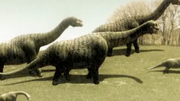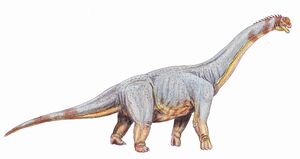m (→In the Media: Removing Category:Saurischians) Tag: apiedit |
No edit summary |
||
| (21 intermediate revisions by 13 users not shown) | |||
| Line 6: | Line 6: | ||
|suborder= Dinosauria |
|suborder= Dinosauria |
||
|class= Reptilia |
|class= Reptilia |
||
| − | |size= |
+ | |size=32 meters (108.5 feet) |
|diet= Herbivore |
|diet= Herbivore |
||
|period=Upper Cretaceous |
|period=Upper Cretaceous |
||
|locate=Modern-Day Egypt}} |
|locate=Modern-Day Egypt}} |
||
| − | '''''Paralititan''''' was a genus of giant [[titanosaur]]ian [[Sauropod]]s that lived throughout the [[Cretaceous Period]]. Because not many fossils of ''Paralititan ''have been found, little is known about them. Fossilized ''Paralititan'' remains were first discovered in the Upper Cretaceous coastal deposits of the Bahariya Formation in Egypt. The fossil was well preserved in the tidal flat deposits, which contained fossil mangrove vegetation. |
+ | '''''Paralititan''''' ("tidal giant") was a genus of giant [[titanosaur]]ian [[Sauropod]]s that lived throughout the [[Cretaceous Period]]. Because not many fossils of ''Paralititan ''have been found, little is known about them. Eats 720 lbs of plant food each day. Fossilized ''Paralititan'' remains were first discovered in the Upper Cretaceous coastal deposits of the Bahariya Formation in Egypt. The fossil was well preserved in the tidal flat deposits, which contained fossil mangrove vegetation. |
| + | |||
==Paleobiology== |
==Paleobiology== |
||
| ⚫ | [[File:Disc paral.png|thumb|left|Monsters Resurrected Paralititan]]Though the remains were well preserved, there were not many. Scientists have determined that the available materials suggest that ''Paralititan'' was among the largest dinosaurs to have ever lived. Researchers have come to the conclusion that ''Paralititan'' may have possessed osteoderms in order to defend itself from large predators. The fossilized specimen appears to have been scavenged by a large carnivore. This opens up the possibility that large carnivorous dinosaurs, such as ''[[Carcharodontosaurus]]'' may have hunted ''Paralititan'' as its prey. It was over 108.5 feet (32.5 meters) long and weighed 65 tons, making it big even by dinosaur standards. It had a long neck that could easily get to the highest parts of trees, and a huge gut designed to digest huge amounts of plant material.[[File:Paralatitan 1.png|thumb|Planet Dinosaur Paralititan]] |
||
| ⚫ | Though the remains were well preserved, there were not many. Scientists have determined that the available materials suggest that ''Paralititan'' was among the |
||
==In the Media== |
==In the Media== |
||
| − | '' |
+ | *''Paralititan ''has been in a few documentaries, one of which was in <u>Monsters Resurrected</u>, where a juvenile was killed by a ''[[Rugops]]'', and is inaccurately shown to be killed by ''[[Spinosaurus]]''. |
| + | *It also was featured in <u>Planet Dinosaur</u>, where a juvenile got stuck in the mud, and was made the rope in a deadly game of tug of war between ''[[Sarcosuchus]]'' and ''Carcharodontosaurus''. |
||
| + | *It was also featured in Ricardo Delgado's <u>Age of Reptiles: Ancient Egyptians</u> mini-series. |
||
| + | |||
| + | == References == |
||
| + | https://www.sciencedaily.com/releases/2001/06/010601081848.htm |
||
[[Category:Titanosaurs]] |
[[Category:Titanosaurs]] |
||
[[Category:Cretaceous dinosaurs]] |
[[Category:Cretaceous dinosaurs]] |
||
| ⚫ | |||
[[Category:Sauropods]] |
[[Category:Sauropods]] |
||
[[Category:Dinosaurs of Africa]] |
[[Category:Dinosaurs of Africa]] |
||
| Line 30: | Line 35: | ||
[[Category:Reptiles]] |
[[Category:Reptiles]] |
||
[[Category:Diapsid Reptiles]] |
[[Category:Diapsid Reptiles]] |
||
| + | [[Category:Planet Dinosaur Creatures]] |
||
| ⚫ | |||
| + | [[Category:Monsters Resurrected Creatures]] |
||
| + | [[Category:Large Animals]] |
||
| + | [[Category:Prehistoric animals of Africa]] |
||
| + | [[Category:Extinct animals of Africa]] |
||
Revision as of 23:27, 27 March 2020
Paralititan ("tidal giant") was a genus of giant titanosaurian Sauropods that lived throughout the Cretaceous Period. Because not many fossils of Paralititan have been found, little is known about them. Eats 720 lbs of plant food each day. Fossilized Paralititan remains were first discovered in the Upper Cretaceous coastal deposits of the Bahariya Formation in Egypt. The fossil was well preserved in the tidal flat deposits, which contained fossil mangrove vegetation.
Paleobiology

Monsters Resurrected Paralititan
Though the remains were well preserved, there were not many. Scientists have determined that the available materials suggest that Paralititan was among the largest dinosaurs to have ever lived. Researchers have come to the conclusion that Paralititan may have possessed osteoderms in order to defend itself from large predators. The fossilized specimen appears to have been scavenged by a large carnivore. This opens up the possibility that large carnivorous dinosaurs, such as Carcharodontosaurus may have hunted Paralititan as its prey. It was over 108.5 feet (32.5 meters) long and weighed 65 tons, making it big even by dinosaur standards. It had a long neck that could easily get to the highest parts of trees, and a huge gut designed to digest huge amounts of plant material.

Planet Dinosaur Paralititan
In the Media
- Paralititan has been in a few documentaries, one of which was in Monsters Resurrected, where a juvenile was killed by a Rugops, and is inaccurately shown to be killed by Spinosaurus.
- It also was featured in Planet Dinosaur, where a juvenile got stuck in the mud, and was made the rope in a deadly game of tug of war between Sarcosuchus and Carcharodontosaurus.
- It was also featured in Ricardo Delgado's Age of Reptiles: Ancient Egyptians mini-series.
References
https://www.sciencedaily.com/releases/2001/06/010601081848.htm
